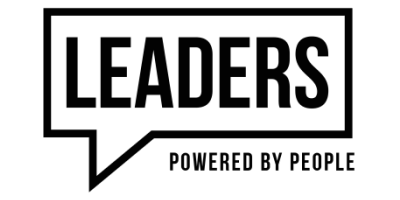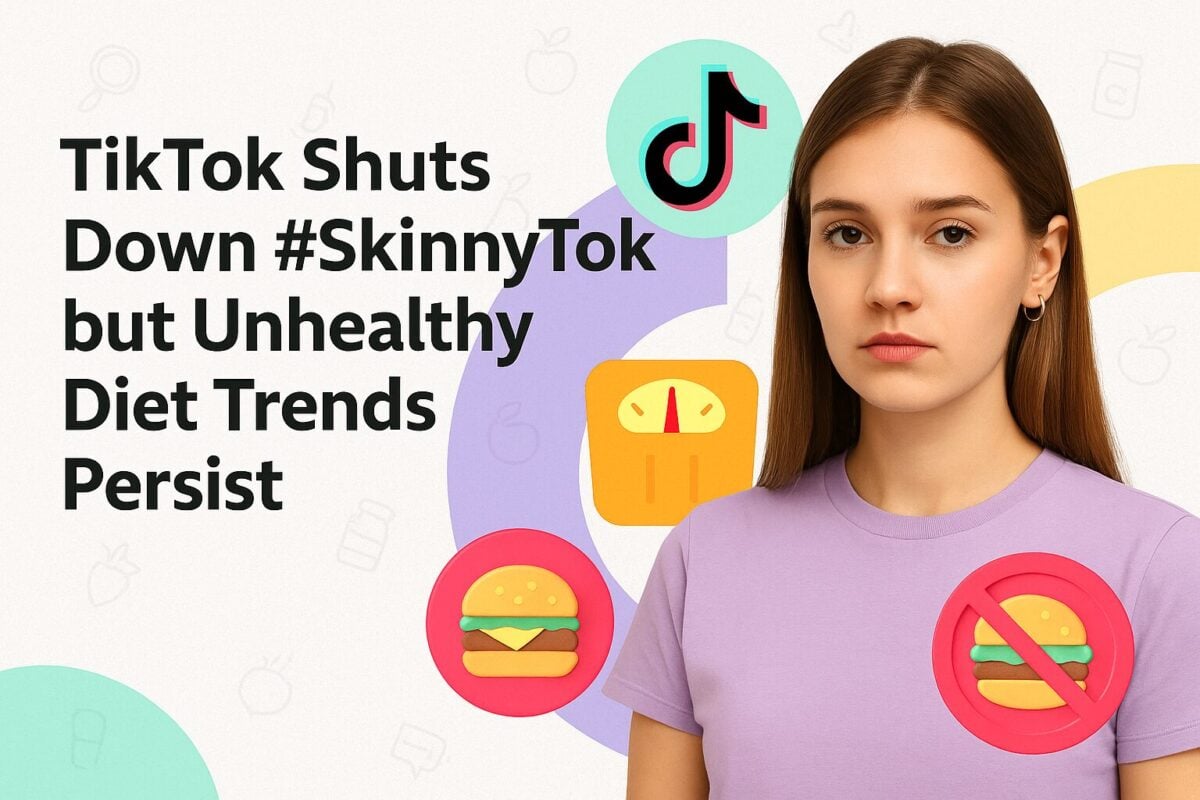One of the earliest problems faced by businesses wanting to engage in influencer marketing was finding suitable influencers with whom to work. Brands first had to find influencers. They then had to slowly build a relationship with the selected influencers, in the hope that they could eventually formalize the process. While this is a truly organic and authentic way to find influencers, it can be a slow process, particularly if your chosen influencers have no wish to participate in influencer marketing. Influencer marketing platforms were born as a way to streamline the influencer discovery phase and speed up the entire process.
The first influencer marketing platforms focused on influencer discovery. Some asked influencers to apply to join their platform, vetting whether they were influential or not. Other platforms use a more algorithmic process, building vast databases of influencers from available social data. In recent years, artificial intelligence (AI) and data mining have become more important in establishing influencer lists.
The third type of influencer platform uses a hybrid of the first two approaches. While these encourage influencers to apply to feature in their databases, and in some case, allow brands to suggest suitable influencers, they also use a complex algorithm to discover any other influencers potentially missed by a self-selection process.
Influencer marketing platforms have also widened the range of tools they offer their clients. Influencer discovery is just one tool, and indeed not all influencer platforms now offer influencer discovery. Some of the additional tools provided by the platforms include:
- Relationship management
- Campaign management
- Influencer marketplace
- Third party analytics
- Influencer content amplification
Here are some of the top influencer marketing platforms that we believe are worth watching in 2025. Note that the Influencer Marketing Hub has carried our extensive reviews on most of the platforms listed. The links to those platforms lead to relevant reviews.
Influencer Services Offered: Influencer Profile Search, Engagement Tools, Campaign Management, Analytics and Tracking Social Networks Catered For: Instagram, Facebook, X (former Twitter) Pricing Tiers: Multiple pricing tiers, available upon request. Find Your Influence (FYI) is a robust influencer marketing platform designed to meet the diverse needs of brands, agencies, and creators. Built on over a decade of expertise in influencer marketing, FYI combines powerful AI-driven technology with personalized managed services to provide brands with a platform that is both flexible and comprehensive. FYI’s platform is built to streamline the entire influencer marketing process, from influencer discovery to campaign management and reporting. With advanced search capabilities like look-alike modeling, keyword targeting, and AI-driven recommendations, brands can easily pinpoint influencers that align with their campaign objectives. Once influencers are onboarded, FYI’s suite of tools, including in-platform messaging, custom surveys, and pricing algorithms, makes managing influencer relationships seamless and efficient. FYI tracking tool Brands can also leverage influencer surveys to gain deeper insights into their preferences and find genuine brand advocates, a feature that helps brands connect with creators who share their passion and values. The platform’s commitment to authenticity and guaranteed results stands out. FYI’s Influencer Promise, backed by years of industry data, is a testament to its focus on building meaningful, ROI-driven campaigns. Brands like AAA and M Booth report significant success with FYI, highlighting its transparency, reliability, and deep understanding of the influencer marketing space. Whether you’re a business looking to boost brand awareness, drive sales, or an agency aiming to deliver exceptional campaigns for clients, FYI’s platform and team of experts provide the foundation to elevate any influencer marketing strategy. With its global network of opted-in creators, deep regulatory knowledge, and hands-on support, Find Your Influence positions itself as a valuable partner in achieving authentic, impactful influencer marketing outcomes. Key Features: Campaign Management, Influencer Marketplace, Search/Discovery, Automated Recruiting, Content Review, Content Library, Campaign Reporting, Influencer Analysis, Audience Analysis, Product/Gifting Tools, Fake Follower/Fraud Detection, Payment Processing, Channels: Instagram, TikTok, Facebook, Pinterest, Youtube Influencer Services Offered: Influencer Discovery, Campaign Management Social Networks Catered For: Facebook, Twitter, Instagram, YouTube, Pinterest, Blogs Pricing Tiers: Upfluence offers its SaaS platform services through a subscription model, with a range of modules available for a starting monthly fee of $478. Upfluence grew out of two products – Façade, an influencer search engine, and Publishr, an influencer management system, and content marketplace. The company evaluated its software and decided to close Publishr down, rebranding the discovery search engine as Upfluence. Over time, they have migrated the best management features over from Publishr and added social listening features, resulting in an all-in-one influencer experience. The Upfluence database is massive, including over one million influencers. Their algorithm updates all of this data in real-time. They analyze every item of content posted for reach and engagement. You can search through the Upfluence database in multiple ways, drilling down in detail. You can place relative weights on your keywords, to help further narrow down your results. Key Features: Influencer Search & Discovery, Relationship Management, Campaign Management, Third Party Analytics, Automated Recruiting, Influencer Lifecycle Management, Team Collaboration Tools, Content Review, Campaign Reporting, Audience Analysis, E-commerce Tools, Product/Gifting Tools, Payment Processing, Social Listening, Affiliate Management, Affiliate Campaigns, Channels: Instagram, Youtube, Facebook, Twitch, Tiktok, Twitter, Pinterest, Blogs Influencer Services Offered: Influencer Discovery, Analytics, Payments, Influencer Management, Campaign Tracking, Influencer Inbox Social Networks Catered For: Instagram, YouTube, and TikTok Pricing Tiers: Three paid plans are available. Initial plans start at $299/month. Free 14-day trial period also available. Modash is a fast-growing influencer marketing platform gaining attention for its extensive database of over 250 million influencer profiles and tailored influencer management solutions. Designed with brands of all sizes in mind, Modash offers a comprehensive toolset that includes influencer discovery, relationship management, and automated content tracking. As Modash co-founder Avery Schrader states, the platform’s ethos is rooted in supporting creators by providing a reliable means for them to be compensated for their work while empowering brands to find the best-fit influencers for their campaigns. One of Modash’s standout features is its Discovery Module, which connects users with their extensive database of influencers across Instagram, TikTok, and YouTube. With the platform’s advanced filtering options, brands can find influencers who align perfectly with their campaign goals, whether in niche categories or specific geographical locations. Modash influencer discovery Additionally, the Lookalikes feature allows users to replicate successful campaigns by finding similar influencers based on audience attributes or content style—a particularly valuable feature for brands seeking consistency across campaigns. Modash Lookalikes feature In terms of relationship management, Modash offers a robust suite that makes organizing and tracking influencer collaborations straightforward. Users can create custom lists, save notes, and label influencers, streamlining the outreach process and ensuring no important details are missed. Modash influencer discovery Modash integrates directly with Gmail, enabling users to send and receive emails with influencers directly through the platform, a time-saving feature that allows for easy referencing of past conversations and notes. For larger teams, the system will indicate if an influencer has previously worked with the brand, which fosters more consistent and organized communication across departments. From performance tracking to real-time campaign monitoring, Modash provides analytics that enable brands to gauge the impact of each influencer collaboration. By integrating with Shopify, brands can manage discount codes, track revenue, and monitor referral traffic directly from the platform. With a recent Series A investment of $11 million, Modash continues to grow and innovate, making it a platform to watch in 2024 and beyond. Modash clients Key Features: Campaign Management, Influencer Discovery, Influencer Analytics, Influencer Campaign Monitoring, Influencer Management, Influencer Services Offered: Influencer Vetting, Discovery, Brand Safety, Brand Fit Social Networks Catered For: Instagram, TikTok, YouTube, Facebook, Pinterest, Snapchat, and X (formerly Twitter) Pricing Tiers: Viral Nation offers customized pricing tailored to each client’s specific needs and campaign scope. For detailed information, it’s best to contact them directly through their website. Viral Nation’s VN Secure sets a new standard in brand safety, offering a robust solution for medium to large enterprises navigating today’s complex social media landscape. In an era where brand reputation can be jeopardized overnight by influencer controversies, VN Secure provides companies with a unique safeguard by thoroughly vetting influencers and maintaining alignment with a brand’s core values. VN Secure solution Just three weeks ago, Viral Nation proudly announced a major update to this already award-winning platform: Viral Nation Secure 2.0, a sophisticated upgrade to VN Secure powered by Google Gemini. As Chief Business Development Officer Emma Ferrara shared, “Secure 2.0 delivers quicker, safer, and more accurate influencer vetting by analyzing public platform histories according to customizable brand risk parameters.” With the new version, brands can access an even deeper level of “creator intelligence,” allowing them to pinpoint and eliminate potential risks before they can impact the brand’s image. This tool is essential for brands looking to engage authentically and strategically in today’s fast-moving digital landscape. VN Secure stands out for its precision and configurability, a quality highlighted by its recent win of the SXSW Innovation Award for Social Media. The platform allows each brand to define its unique standards for what constitutes “safe” content, considering the nuanced thresholds for content categories such as nudity, drug use, or copyrighted music, making VN Secure an invaluable tool for brands with varied content sensitivities. This AI-powered brand reputation management tool is not only revolutionary for its thorough vetting capabilities but also for its adaptability. Viral Nation Secure 2.0 monitors content on all major social media platforms, including Instagram, TikTok, YouTube, Facebook, Pinterest, Snapchat, and X (formerly Twitter). This comprehensive coverage means that brands can engage with a vast influencer network without fear, as the platform continues to monitor influencers’ activities over time, ensuring that no new content will slip through the cracks. Viral Nation’s platform can handle high volumes, demonstrated by a recent case in which VN Secure processed 23 years’ worth of video content across 70,000 influencers in just four months, delivering reliable results that would be impossible without its AI-driven system. Beyond brand safety, VN Secure also serves as a social listening tool, offering a window into public sentiment by tracking brand mentions, keywords, and competitor names. This additional functionality gives brands insight not only into potential safety concerns but also into broader market perception, allowing them to make proactive, strategic decisions. With VN Secure, brands can rely on timely alerts for flagged content, complete with detailed timestamps and automatic transcription, making it easy to review, address, and mitigate any potential issues. As influencer marketing continues to grow in significance, tools like VN Secure are indispensable. Viral Nation’s foresight and innovation have positioned VN Secure as an industry leader, earning it widespread recognition, including a recent feature in Adweek and numerous awards. Key Features: Influencer Analysis, Moderation Tolerance Feature, Channels: TikTok, Instagram, Facebook, X (Formerly Twitter) Influencer Services Offered: Influencer Discovery, Campaign Management, Third Party Analytics Social Networks Catered For: Instagram, Facebook, Twitter, YouTube, Pinterest, Twitch Pricing Tiers: Customized, but an annual fee contingent on the number of users you want to give access to the software. Julius began life in 2012 as a platform named Thuzio. Before long, Thuzio became a type of web-based talent agency for current and former athletes. Before too long, the platform had moved into influencer discovery and had an easier-to-pronounce name, Julius. More recently, they have expanded their offerings, and are now a full-fledged self-service marketing suite. Julius works with a database of more than 120,000 influencers. Although Julius uses AI and algorithms to come up with suggested influencers, it does not recommend anybody before they have first had their data vetted by humans, who can also flesh out their profile. Julius includes a detailed data search engine, with more than 50 different criteria for narrowing a search—covering demo- and psychographic data. You can easily make shared lists with your team. Julius includes an excellent comparison feature. You can compare up to five influencers at a time, across a range of data features. This makes it particularly easy to see how influencers stack against one another. Once your campaign is underway, you can easily find anything you want to know about your campaign. It provides in-depth reports, with clear visualizations. Key Features: Search/Discovery, Influencer Relationship Management, Campaign Management, Campaign Reporting, Influencer Analysis, Audience Analysis, Forms/Compliance, Channels: TikTok, Facebook, Twitter, Instagram, Pinterest, Snapchat, YouTube Influencer Services Offered: Influencer Search & Discovery, Relationship Management, Campaign Management, Third Party Analytics Social Networks Catered For: Instagram, YouTube, Facebook, Twitter, Blogs, TikTok Pricing Tiers: Freemium – Free (1 user, 3 influencers) / Standard – rate varies by number of influencers (5 users, 25 – 2,000+ influencers) / Premium – rate varies by number of influencers (5 users, 25 – 2,000+ influencers, multiple other features, including campaign stats, and content monitoring) Stellar takes a different approach to many of the other platforms. It allows you to turn Excel spreadsheets and social media account pages into your own influencer marketing platform. As it advertises, once you use Stellar, you will have no further need of spreadsheets for you influencer campaigns. There are three main sections within the Stellar platform – Influencers, Groups, and Reports. You add your influencers in the Influencer section. As it doesn’t include influencer discovery, you may need some other tool to find your influencers initially. The Influencer section of Stellar replaces any database or spreadsheet you may currently use to keep your influencer records. Stellar includes a browser extension to make it easier for you to add new Influencers in the future. Once you’ve entered your influencers, Stellar will import their profile details, and provide essential information from their biggest social account. You can see detailed metrics going back 30 days. Once you have uploaded the details of your influencers, you can organize them into groups. You can set up groups in virtually any way you can think of. Although you can place people into groups in the separate Groups section, it is often simpler to do so from within the Influencer’s module. The Reports section is comprehensive. You can run reports on both your own and your competitors’ campaigns. You can create top-level reports, but you can also drill down to reports on the performance of individual influencers in each campaign. Key Features: Influencer Relationship Management, Team Collaboration Tools, Content Library, Campaign Reporting, Influencer Analysis, Audience Analysis, Fake Follower/Fraud Detection, Competitor Research, Channels: Facebook, Instagram, Twitter, Youtube, Blog, TikTok Influencer Services Offered: Influencer Discovery, Campaign Management Social Networks Catered For: Facebook, Twitter, Instagram, YouTube, Pinterest, Snapchat Pricing Tiers: Customized pricing. NeoReach mines the web for social data, that it indexes and makes available for searches on its platform. Its programmers developed an algorithm that mines the internet for social data, discovering influencers, rather than letting influencers opt-in themselves. It now has over 3 million influencers in its database. NeoReach recognizes the importance of data. Influencer searches begin with a keyword. NeoReach searches through its database of users and their posts to discover a march for your selected keyword. You can then refine your searches by factors such as conversation topic, social channel, social metrics per channel, audience demographics, and audience psychographics. In addition to searches you may make as a user, NeoReach offers additional recommendations, using AI. The more you use NeoReach, the better its influencer recommendations will be. NeoReach also includes a full set of campaign management tools. It acts as a centralized communications hub between you and your influencers. It continues its emphasis on data in the reports it gives its clients. One particularly useful statistic is NeoReach’s own Influencer Media Value (IMV), which is its adaptation of the more traditional Earned Media Value (EMV). Key Features: Campaign Management, Search/Discovery, Influencer Relationship Management, Team Collaboration Tools, Campaign Reporting, Influencer Analysis, Audience Analysis, Forms and Compliance, Channels: Facebook, Twitter, Instagram, YouTube, Pinterest, Snapchat Influencer Services Offered: Influencer Discovery, Campaign Management, Third Party Analytics Social Networks Catered For: Instagram, Facebook, Twitter, YouTube, Pinterest, Snapchat, Blogs Pricing Tiers: Basic – $50/mo. (50 searches /mo., 20 results/search, limited search filters, 1 list of 10 influencers) / Pro – $100/mo. (150 searches /mo., 50 results/search, limited search filters, 2 lists of 25 influencers) / Premium – $500/mo. (500 searches /mo., 1,500 results/search, better search filters, 4 lists of 25 influencers) / Enterprise – custom pricing (unlimited searches, results/search, and lists. Other campaign management tools) Open Influence began life as InstaBrand, and grew out of a completely different product – a “fashion sales aggregation thingy.” Although it may have started as fashion-focused, Open Influence ended up as an influencer platform, for brands in any industry. Although there are two comparatively cheap small business plans, they have little real practical value. Most businesses will need to have at least a Premium plan to make use of Open Influence. The critical point of difference with Open Influence is its focus on images. It includes advanced image recognition technology. This makes it easier to find influencers who share pictures of any topic that interests you. Open Influence’s AI labels the content directly and accurately. It includes an intelligent algorithm that means it can almost “understand” what an image shows. This is particularly useful for finding people whose style and audience fit the image of your brand. You can also use audience demographics and psychographics to refine your search. One unusual feature of Open Influence is its Mood Board, which gives you an indication of what you campaign will ultimately look like, based on influencers’ past posts. This gives an excellent way of seeing whether an influencer’s style and aesthetics match your own. Key Features: Search/Discovery, Content Review, Content Library, Campaign Management, Campaign Reporting, Influencer Analysis, Audience Analysis, Visual Discovery, Channels: Instagram, Facebook, Twitter, YouTube, Pinterest, Snapchat, Blogs Influencer Services Offered: Monetization Tools, Brand Collaborations, Analytics and Insights, Growth Support Social Networks Catered For: Instagram, TikTok, Pinterest, Facebook, YouTube, Twitter Pricing Tiers: Several pricing tiers available. Plans start from $417/month. LTK, formerly known as rewardStyle, is an influencer marketing powerhouse, particularly suited for e-commerce brands aiming to leverage creator partnerships for direct sales. Founded by Amber Venz Box, a pioneer in transforming influencer marketing, LTK bridges the gap between social influence and e-commerce, turning creator-led recommendations into shoppable moments. Designed with brands in mind, LTK scales faster than ads. With $5 billion in annual brand sales, LTK boasts 3x higher conversion rates compared to social ads, doubling creator reach while offering 14 years of proprietary data for unique consumer insights. LTK brands LTK Connect is the platform’s primary self-service tool, giving brands access to an exclusive network of creators. This closed ecosystem comprises vetted influencers who have a proven track record in driving sales, making it unique compared to traditional influencer marketplaces. LTK influencer marketplace In essence, brands don’t have to sift through vast, generalized profiles. Instead, they can select from experienced creators who have been invited to join the platform based on their ability to convert interest into measurable sales—a major advantage for brands seeking efficiency and assured ROI. LTK discovery and campaign creation features The discovery and campaign creation features in LTK Connect stand out for their intuitiveness and level of support. The platform guides brands through campaign setup, offering best practices and custom requirements tailored to different social channels. This attention to detail helps brands maximize campaign effectiveness from the outset. For example, brands can specify deliverables across various social platforms, and LTK ensures creators meet these requirements before submission, streamlining the approval process. An added benefit is LTK’s comprehensive campaign reporting. Since the platform is intertwined with the LTK shopping app, brands gain access to tangible metrics such as conversion rates, average order values, and sales figures—crucial insights often missing from influencer platforms that focus more on engagement than sales. LTK Match AI LTK’s Match AI tool further enhances brand-creator alignment by drawing on 13 years of proprietary data. This AI-powered feature allows brands to find influencers with optimal audience alignment, maximizing the impact of each collaboration. Additionally, LTK Boost and LTK Ads extend reach by boosting creator content across social channels, effectively amplifying visibility and engagement. Key Features: Search/Discovery, Content Review, Campaign Management, Campaign Reporting, Influencer Analysis, Audience Analysis, Product/Gifting Tools, Forms and Compliance, Payment Processing, Channels: Instagram, TikTok, YouTube, Facebook, Pinterest, Twitter, Blogs, LTK App Influencer Services Offered: Influencer Discovery, Campaign Management, Influencer Marketplace, Third Party Analytics Social Networks Catered For: Facebook, Instagram, Twitter, YouTube Pricing Tiers: Contact Tagger Media for pricing information Tagger Media provides a range of tools to help brands through the influencer marketing process. It features an opt-in database of over one million influencers. It actually began in 2015 as a music recommendation engine. It tracked social conversations and analyzed fan preferences to come up with relevant music suggestions. It was not long, however, before Tagger Media realized that their algorithms could be of more use recommending potential influencers to brand clients. The platform has far more features than just an influencer discovery engine, however. It includes most of the features of an influencer marketplace. Once you have found the influencers you wish to work with you can create campaigns for them within the platform. Indeed, you may opt to create your campaign first, then use the discovery engine, and then invite your preferred influencers to work with you. The best feature of Tagger Media, however, is its focus on psychographics. The influencer discovery engine includes social listening. This analyzes what people are talking about, as well as concrete things like their interests. Their Affinity Engine can dissect audience interests and note where they overlap. Key Features: Search/Discovery, Automated Recruiting, Influencer Marketplace, Team Collaboration Tools, Content Library, Campaign Management, Campaign Reporting, Influencer Analysis, Audience Analysis, Fake Follower/Fraud Detection, Payment Processing, Social Listening, Competitor Research, Channels: Facebook, Instagram, Twitter, YouTube, TikTok Influencer Services Offered: Third Party Analytics Social Networks Catered For: Instagram Pricing Tiers: A Pay-As-You-Go model, no subscription required. You buy tokens. Each token gets you one influencer report) Tokens range from $1.99 each to $0.72, depending on the quantity you buy. HypeAuditor is another tool that focuses solely on analytics, eschewing traditional platform features such as influencer discovery. It began life as a more conventional influencer marketing marketplace but chose to move away from what they saw as a crowded market. It changed direction in 2017 to become a vast database powered by artificial intelligence that’s indexed nearly 3 million Instagram profiles so far. In particular, HypeAuditor repurposed to fight influencer fraud. Its analytics aims to give brands and agencies very detailed insights into influencers and their audiences. HypeAuditor decided that it should place its focus on audience quality. That way, it provides far more use to brands than merely spotting fraud. It uses 28 different metrics and scores, to give users a thorough understanding of whom they’re dealing with. It calculates an Audience Quality Score (AQS) for each influencer – a score ranging from 1 to 100, with higher scores indicating better quality audiences. You should feel comfortable working with any influencer with an AQS of 70 or more. The report provides numerous other valuable analytics, including recommendations of followers reachability and followers quality. It splits audiences by type, e.g., real people, influencers, mass followers, and suspicious accounts. Key Features: Search/Discovery, Campaign Reporting, Influencer Analysis, Audience Analysis, White Label Reporting, Fake Follower/Fraud Detection, Channels: Instagram, YouTube, TikTok, Twitch, Twitter Influencer Services Offered: Influencer Discovery, Relationship Management, Campaign Management, Influencer Content Amplification Social Networks Catered For: Instagram Pricing Tiers: Contact Model Village for pricing information As Model Village’s name indicates, an influencer platform that focuses strongly on fashion models. The platform has signed up over 5,000 fashion models, from the world’s leading agencies. For the platform to accept you as an influencer, you must be an agency-signed model signed with one of their partner agencies and have at least 1,000 genuine followers on Instagram. Fashion brands create campaigns through the Model Village SaaS dashboard. They can use the dashboard to shortlist the influencers with the profiles that fit their brand. Once they have decided on suitable influencers, they can use the system to automate the shipping of products to selected influencers. They can also book influencers to attend brand events and to plan and schedule Instagram Stories. Brands go through a three-step process when using Model Village for a campaign. They begin by creating a campaign brief and setting audience targeting. Once they have selected influencers, the influencers then create content that the brand can approve or decline. Once posts go live, brands can use the platform to track performance in real-time, using advanced analytics to assist them. Influencer Services Offered: Influencer Discovery, Relationship Management, Campaign Management, Third Party Analytics Social Networks Catered For: Instagram, YouTube, Blogs Pricing Tiers: Either Self-Service or Managed Service. Contact Collabary for precise payment details. 30-day Free Trial. Content creators join free. Collabary offers two levels of service, depending on whether you want to do it yourself, or would prefer a fully managed campaign. They target both brands and agencies. They also encourage content creators to sign up to the platform for free. Collabary believes that if content creators sign to work with the platform they have already indicated a willingness to work as influencer marketers, and it makes them more visible to interested brands. Their minimum requirements for content creators are a minimum of 2/3k – 5k followers, no bought followers, and likes, a decent frequency of posting. Content creators must be over 18 years old (or have parental sign-up), or alternatively, already be managed by an agency/ agent. Brands (who choose the self-service option) go through six stages on the platform. A fully managed campaign uses similar steps, although Collabary staff performs most of the steps. Influencer Services Offered: Influencer Discovery, Campaign Management, Relationship Management, Third Party Analytics Social Networks Catered For: YouTube, Twitch, Instagram Pricing Tiers: Pay for actualized campaigns only. No monthly fees. Free for influencers. Matchmade provides a platform that brings advertisers and influencers together for targeted and measured campaigns. It specializes in gaming, allowing gaming companies to work with the best gaming influencers. Matchmade’s algorithm attempts to match up gaming advertisers with those gaming influencers who have the best audience to suit the game. From the influencer’s perspective, the platform offers an easy way to find sponsored deals from products their audience will enjoy. Influencer Services Offered: Influencer Discovery, Relationship Management, Campaign Management, Third Party Analytics Social Networks Catered For: Instagram, Twitter, YouTube, Blogs Pricing Tiers: Setup Fee $0. Self-Service (for budgets of $5K+) – 15% on top of each collaboration. Fully Managed (for budgets of $50K+) – 25% of your total campaign budget. Creators pay a 5% processing fee from their payouts. PitchBoard helps brands to connect and collaborate with the right influencers seamlessly. Its AI-powered platform includes intelligent matchmaking, so businesses don’t have to trawl through long lists. Audience verification checks ensure brands don’t have to deal with fake followers. The platform uses high-end AI technology to automate background tasks like profiling influencer audiences, understanding psychological traits, and measuring engagement data. All brands have to do is explain their goals and target audience through a simple campaign creation form. The platform provides detailed insights into a creator’s audience. It even predicts the sort of engagement an arrangement might get. It includes brand safety analysis, with details on such as emotion distribution and use of bad language. Clients can easily keep track of campaigns with daily, weekly, and monthly progress reports. There are four steps to the PitchBoard process: Influencer Services Offered: Influencer Discovery, Campaign Management Social Networks Catered For: Facebook, Instagram, LinkedIn, Snapchat, Twitter, WhatsApp, YouTube, TikTok Pricing Tiers: Contact LEADERS for details. LEADERS offers a range of influencer marketing services, including an influencer platform. It is a revolutionary technology-driven influencer marketing platform and agency. The company has operated for a decade and has now established a network of over 1 million influencers. Their platform gives businesses the ability to discover influencers best suited for the brand, review and approve the content influencers create and monitor a campaign’s performance in real time. LEADERS has created a data management platform (DMP) that gives accurate and in-depth information to ensure successful influencer marketing campaigns with positive ROIs. Some of the less common features include facial recognition to determine gender, ethnicity, and age, mapping of general location according to last 30 posts using longitude/latitude coordinates, and image recognition to identify segmentation more accurately. LEADERS also offers a management platform, where brands can manage influencers throughout the process and track their campaign status. It also features a Tinder-like dashboard allowing brands to “choose their LEADERS,” and approve everything before it goes online. The dashboard highlights KPI’s in real time. Influencer Services Offered: Influencer Discovery Social Networks Catered For: Instagram, Facebook, Twitter, YouTube, Pinterest Pricing Tiers: Pro (1 user, 6 lists, 20 profiles per list) / Platinum (2 users, 6 lists per user, 30 profiles per list) / Enterprise (4 users, 12 lists per user, 50 profiles per list). Customized pricing. HYPR was one of the first platforms to realize the importance of data to influencer discovery. We stress multiple times on the Influencer Marketing Hub, the importance of selecting influencers whose followers match your target market. That can be tricky; however, HYPR makes it easier to find influencers with the right followers for your business. HYPR’s database includes more than 10 million influencers. The system uses complex algorithms to analyze social media messages to help it offer relevant influencer suggestions. Unlike many of the platforms here, HYPR has restricted its features to providing data for influencer discovery. It has resisted trying to become the Swiss Army Knife of influencer platforms and found its clear niche. HYPR is very much a tool for searching and analyzing influencers. It does also collect data on live campaigns now, however. Key Features: Influencer Search & Discovery, Influencer Outreach and Engagement, Performance Tracking with Audience Demographics and Conversion Attribution, Global Influencer Payment, Fraud Detection and Audience Health, Channels: Instagram, Facebook, Twitter, YouTube, Pinterest Influencer Services Offered: Influencer Search & Discovery, Relationship Management, Campaign Management, Third-Party Analytics Social Networks Catered For: Facebook, Instagram, Twitter, YouTube, Pinterest, Twitch, Blogs Pricing Tiers: Contact CreatorIQ for pricing information CreatorIQ analyses over 1 billion public social accounts and their content, checking everything against a set of criteria to see if they merit being added into the platform database. Currently, more than 15 million creator accounts have met the criteria and entered into the system. CreatorIQ takes a “content first” approach to discovery. It analyzes at all the discrete parts of any given piece of content and makes logical inferences. It uses image recognition to isolate all of the components of images. It makes a point of weeding out fake influencers with fake followers. The AI assigns each influencer an “Integrity Quotient,” which can help you discern just how authentic an audience is. You can invite potential influencers via email to join your network. Influencers create an account, fill out tax and compliance forms, self-identify their interests, and set up their payment options. They also connect their social accounts to your portal and give CreatorIQ permission to access their data. This provides more reliable information about their audience and engagement. It looks, feels, and acts like an influencer marketplace, but it’s your marketplace, and you don’t have to compete with anybody else. CreatorIQ is exhaustive in its ability and scope. It looks like the product of a person who’s lived and breathed marketing for decades. It is, however, designed for large businesses and enterprises. All the companies who CreatorIQ highlight as clients have earnings of $100M or more. Key Features: Search/Discovery, Automated Recruiting, Influencer Relationship Management, Content Review, Campaign Management, Campaign Reporting, Influencer Analysis, Audience Analysis, E-commerce Tools, Product/Gifting Tools, Forms and Compliance, Fake Follower/Fraud Detection, Payment Processing, Channels: Facebook, Instagram, Twitter, YouTube, Pinterest, Twitch, Blogs Influencer Services Offered: Influencer Discovery, Relationship Management, Campaign Management, Influencer Marketplace Social Networks Catered For: Instagram, YouTube, Facebook, Twitter, Pinterest, Blogs Pricing Tiers: Basic (1 user, 1 active campaign) / Pro (4 users and 4 active campaigns) / Enterprise (unlimited users and 10 active campaigns). Customized pricing. AspireIQ was formerly known as Revfluence (and that is the term we have used in previous influencer marketing platform posts on the Influencer Marketing Hub). AspireIQ offers tools to help with virtually all stages of an influencer campaign. It began as an influencer discovery platform but has added other tools over time. It was one of the first platforms to add robust influencer and campaign management tools. An influencer needs to have an account on the platform to be able to participate in campaigns; however, the database of influencers isn’t restricted to those who’ve opted in. The influencer discovery software uses an algorithm to crawl through a massive amount of social data to find suitable influencer suggestions for campaigns. A more recent focus of AspireIQ has been on retaining successful influencers. They recognize the current trend towards building lasting, meaningful influencer relationships. You can quickly identify high performing influencers, and AspireIQ provides you with tools to nurture these relationships. It even includes a recommendation engine that suggests similar types of influencers, once you have found successful influencers. Key Features: Search/Discovery, Influencer Relationship Management, Influencer Marketplace, Team Collaboration Tools, Content Review, Content Library, Campaign Management, Campaign Reporting, E-commerce Tools, Product/Gifting Tools, Forms and Compliance, Payment Processing, Social Listening, Competitor Research, Visual Discovery, Influencer Content Amplification, Channels: Instagram, YouTube, Facebook, Twitter, Pinterest, Blogs Influencer Services Offered: Third Party Analytics Social Networks Catered For: Instagram Pricing Tiers: Free – $0/month (1 user, limited analytics) / Premium – $49/user/mo. (all Analisa features) Analisa is another influencer tool that has taken a different turn from the traditional influencer discovery platform. It is also much cheaper than most of the other influencer marketing platforms covered in this post. Analisa is strongly data-focused, or to be more precise analytics-focused. It doesn’t just supply raw data – it includes analysis of that data, often in great detail. You can run two types of reports with Analisa – an @account report and a #hashtag report. @Account reports give you in-depth analytics about an influencer. This includes engagement rates, like rates, comment rates, average engagement rates, total posts, tags, and mentions, posting map, posting activity and audience engagement, average likes and comments per post, with average engagement rates, total posts (with a weekly breakdown), and caption words and hashtags most used. #Hashtag reports allow you to monitor campaigns. These give you in-depth analytics on audience and engagement, total posts, total follower reach, total engagement, geolocation, average and total engagement per day, total follower reach per day, posting activity and any audience engagement, caption words and hashtag most used, and participation. The #hashtag report also goes into depth about the influencers’ performance. Key Features: Campaign Reporting, Influencer Analysis, Audience Analysis, Fake Follower/Fraud Detection, Channels: Instagram, TikTok1. Find Your Influence



2. Upfluence


3. Modash
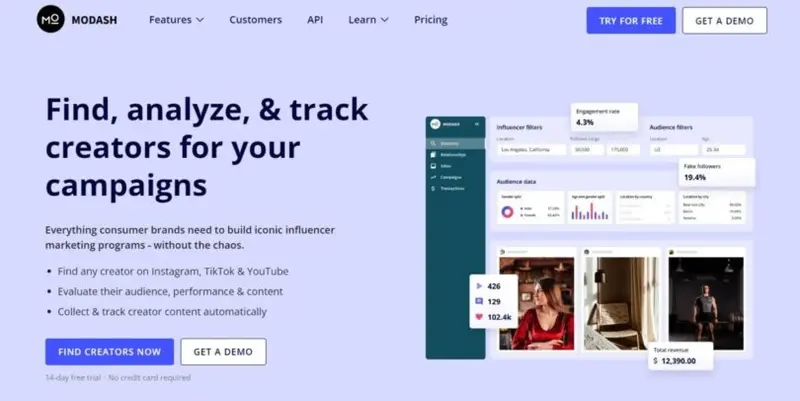
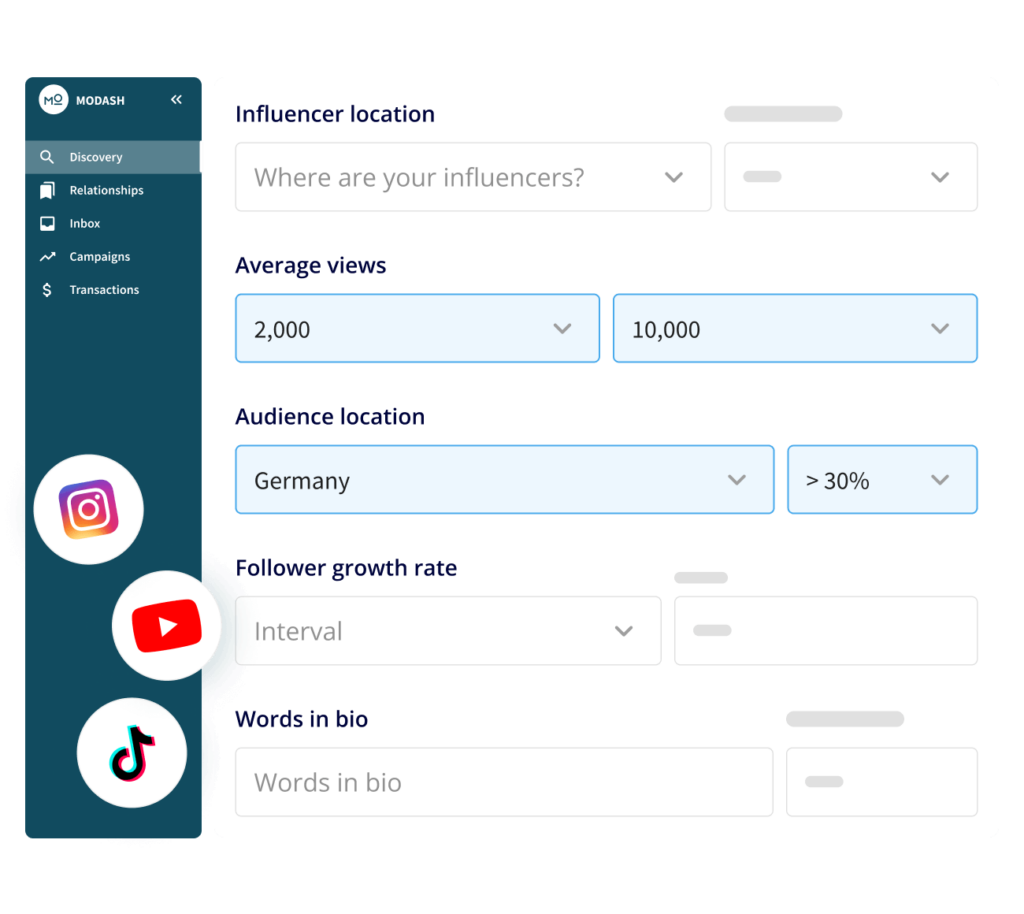

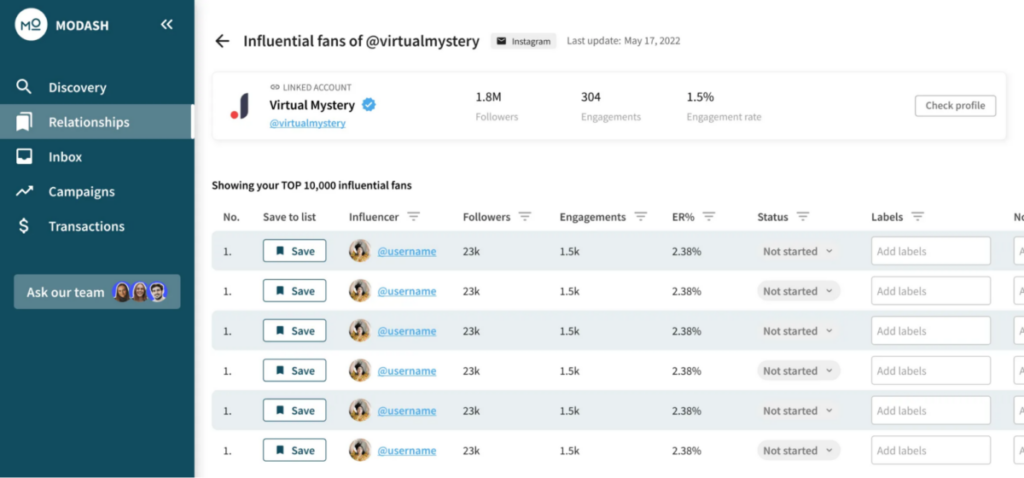


4. Viral Nation Secure™

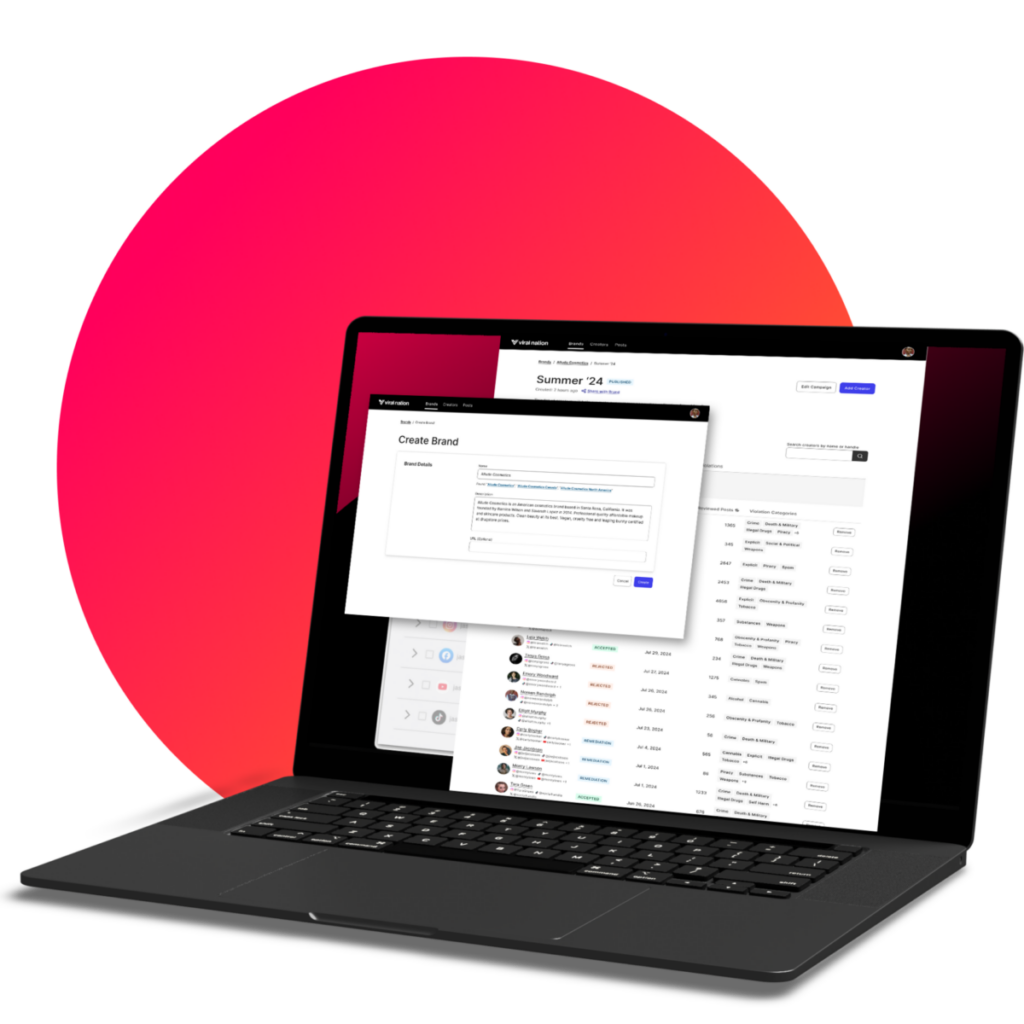

5. Julius


6. Stellar


7. NeoReach


8. Open Influence


9. LTK (formerly rewardStyle)






10. Tagger Media


11. HypeAuditor


12. Model Village

13. Collabary

14. Matchmade

15. PitchBoard

16. LEADERS

17. HYPR


18. CreatorIQ


19. Aspire (formerly AspireIQ)


20. Analisa


